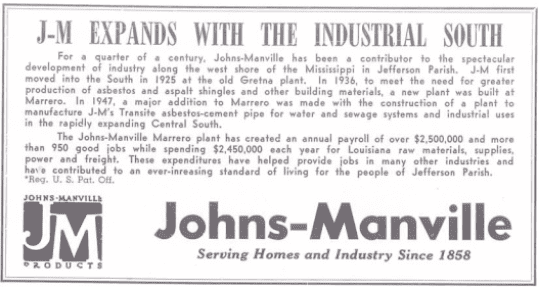When Johns-Manville (J-M) built their Marrero, Louisiana plant to manufacture asbestos-based products in the 1930s, the company already knew that asbestos posed a health risk. Through ads and other marketing, however, it was touted as a significant asset to the community.
That asset turned into significant health issues as, over the decades, workers from the J-M plant have experienced asbestos-related diseases such as malignant mesothelioma and lung cancer from dust they inhaled while working. These life-threatening diseases often take multiple decades before symptoms are seen and a diagnosis is made.
In addition to the workers, local citizens and family members of workers have developed these serious, and often deadly, diseases. Of the many asbestos-laden products manufactured at the Marerro plant, one of the earliest was asbestos pipes. In the process of manufacture, both crocidolite and amosite asbestos were used. Tragically, workers carried fibers home through wearing contaminated clothing while in their cars, hugging and playing with children when they arrived home and laundering these work clothes at home, usually by the wife. The minuscule asbestos fibers became airborne when touched or disturbed and were inhaled by family members.
This person-to-person spread of fibers was not the only manner large portions of Marrero citizens were exposed. Over a period of years, Johns-Manville also populated the environment with deadly fibers through the distribution of scrap containing high levels of asbestos waste to homes and schools for paving driveways and playgrounds. As vehicles and children playing stirred up the asbestos, countless people, many of whom are only now showing signs of disease, breathed in fibers. Brett Powers, attorney at DuBose Law Firm, New Orleans, stated, “The reckless endangerment of employees, their families, and the overall environment of Marerro was caused by the incomprehensible and irresponsible action of the asbestos industry.”
Many of those who developed malignant mesothelioma sued J-M for negligence and liability in multiple areas, including the manufacture, distribution, and use of products known to have a high potential for serious injury. They also accuse J-M of failure to provide safety instructions and equipment, of neglecting to truthfully report results of product testing and medical studies, and of continuing the use of asbestos when alternative materials were available. J-M eventually filed for bankruptcy protection in the 1980s.
However, the consequences of the asbestos contamination of Marrero will live on indefinitely for families of past victims and for the victims who are not yet diagnosed.

